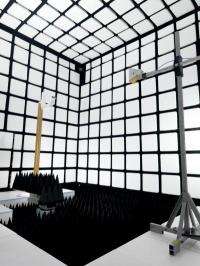Measuring the next successful antennas for in-body health monitoring devices

Antennas for the latest implanted medical devices are being developed by Queen Mary University of London and tested through a unique piece of kit at the UK's National Physical Laboratory (NPL).
In the near future in-body medical devices such as pacemakers will use radio frequency (RF) technology to improve healthcare for patients. A low-powered, two-way wireless communications system linking an in-body device to a monitoring system can provide up-to-the minute patient data to allow doctors to adjust treatment as soon as it is needed. Devices will read data every night when the patient is asleep and send reports to the physician at the hospital, via the telephone system or Internet.
Antennas are vital to the operation of these systems. They need to be small, light, high performing but low-powered, have limited radiation directed at the wearer and be built into the implant. They also need to be made of a material that is biocompatible as well as a good electrical performer.
To ensure the wireless implants work with monitoring systems we need to be able to measure how the radio waves behave when transmitted. Coaxial cable is traditionally used to measure the performance of small electric antennas. However, electrically small antennas for wireless communications applications are can excite common mode currents on coaxial cables - producing unwanted radiation of common mode current and with it distorted results.
NPL , the UK's National Measurement Institute, has achieved a breakthrough in the non-invasive measurement of electrically small antennas. By connecting omni-directional antennas, to an optical fibre instead of a coaxial cable they were able to remove the effects of cable reflections and most notably the radiation of common mode current.
The system was put to the test by the Body-Centric Wireless Sensor Lab (BodyWiSe) at Queen Mary University of London led by Professor Yang Hao. Researchers Dr Marie Rajab, Dr George Palikaras and Andrea Sani have developed an implantable Radio Frequency Identification (RFID) tag made up of a PIFA antenna type that has been optimised to operate whilst embedded in an artificially fabricated three-layer structure representative of skin, fat and muscle.
The device was tested by both a standard coaxial cable and NPL's fibre optic set-up and the results were compared. The result showed that the use of the fibre optic system can significantly decrease measurement errors caused by flowing common mode currents, in this case by as much as 18 dB.
NPL's Martin Alexander, Principal Research Scientist, said:
"This breakthrough could help the development of the next generation of miniature in-body technology designed to save even more lives. NPL achieved it through a collaborative partnership with optical communications company Seikoh-giken. Together we developed a very small RF-optical converter which reproduces the RF signal in full and has a minimal effect on the antenna performance. A miniature RF-optical transducer enables an optical fibre connection to the antenna, thereby eliminating the large distortion associated with the unwanted radiation from a coaxial cable."
Source: National Physical Laboratory


















